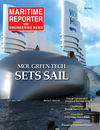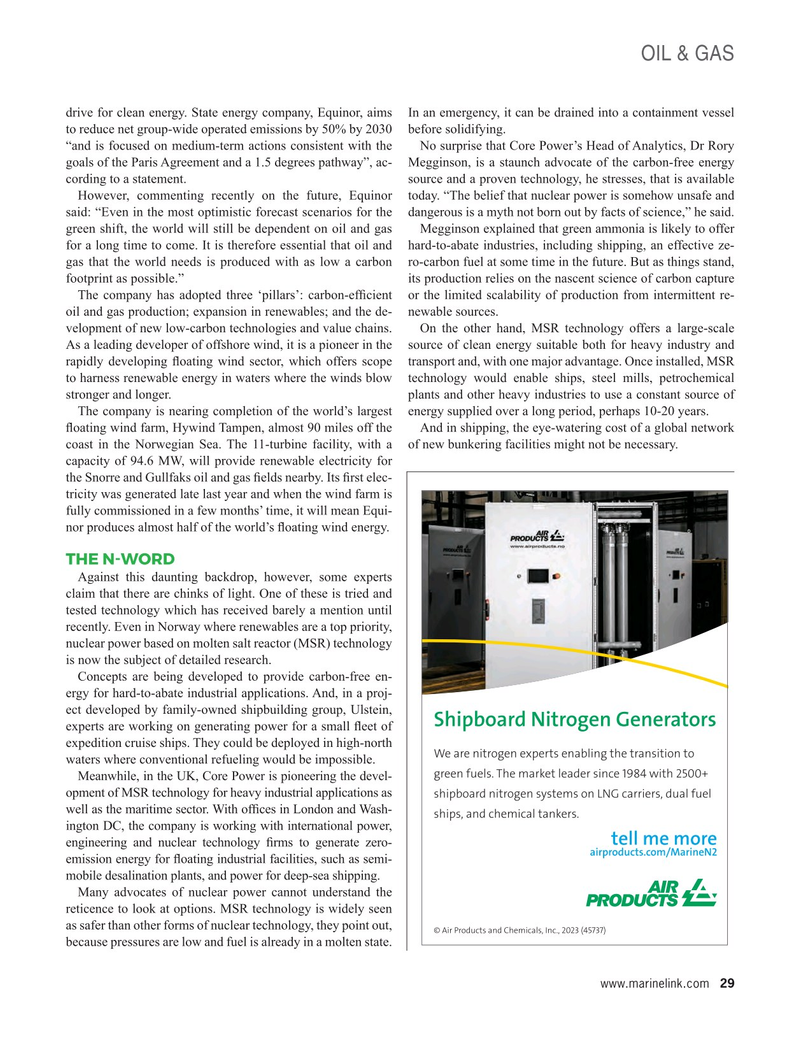
Page 29: of Maritime Reporter Magazine (May 2023)
Green Ship Technologies
Read this page in Pdf, Flash or Html5 edition of May 2023 Maritime Reporter Magazine
OIL & GAS drive for clean energy. State energy company, Equinor, aims In an emergency, it can be drained into a containment vessel to reduce net group-wide operated emissions by 50% by 2030 before solidifying. “and is focused on medium-term actions consistent with the No surprise that Core Power’s Head of Analytics, Dr Rory goals of the Paris Agreement and a 1.5 degrees pathway”, ac- Megginson, is a staunch advocate of the carbon-free energy cording to a statement. source and a proven technology, he stresses, that is available
However, commenting recently on the future, Equinor today. “The belief that nuclear power is somehow unsafe and said: “Even in the most optimistic forecast scenarios for the dangerous is a myth not born out by facts of science,” he said.
green shift, the world will still be dependent on oil and gas Megginson explained that green ammonia is likely to offer for a long time to come. It is therefore essential that oil and hard-to-abate industries, including shipping, an effective ze- gas that the world needs is produced with as low a carbon ro-carbon fuel at some time in the future. But as things stand, footprint as possible.” its production relies on the nascent science of carbon capture
The company has adopted three ‘pillars’: carbon-ef? cient or the limited scalability of production from intermittent re- oil and gas production; expansion in renewables; and the de- newable sources. velopment of new low-carbon technologies and value chains. On the other hand, MSR technology offers a large-scale
As a leading developer of offshore wind, it is a pioneer in the source of clean energy suitable both for heavy industry and rapidly developing ? oating wind sector, which offers scope transport and, with one major advantage. Once installed, MSR to harness renewable energy in waters where the winds blow technology would enable ships, steel mills, petrochemical stronger and longer. plants and other heavy industries to use a constant source of
The company is nearing completion of the world’s largest energy supplied over a long period, perhaps 10-20 years. ? oating wind farm, Hywind Tampen, almost 90 miles off the And in shipping, the eye-watering cost of a global network coast in the Norwegian Sea. The 11-turbine facility, with a of new bunkering facilities might not be necessary. capacity of 94.6 MW, will provide renewable electricity for the Snorre and Gullfaks oil and gas ? elds nearby. Its ? rst elec- tricity was generated late last year and when the wind farm is fully commissioned in a few months’ time, it will mean Equi- nor produces almost half of the world’s ? oating wind energy.
THE N-WORD
Against this daunting backdrop, however, some experts claim that there are chinks of light. One of these is tried and tested technology which has received barely a mention until recently. Even in Norway where renewables are a top priority, nuclear power based on molten salt reactor (MSR) technology is now the subject of detailed research.
Concepts are being developed to provide carbon-free en- ergy for hard-to-abate industrial applications. And, in a proj- ect developed by family-owned shipbuilding group, Ulstein,
Shipboard Nitrogen Generators experts are working on generating power for a small ? eet of expedition cruise ships. They could be deployed in high-north
We are nitrogen experts enabling the transition to waters where conventional refueling would be impossible. green fuels. The market leader since 1984 with 2500+
Meanwhile, in the UK, Core Power is pioneering the devel- opment of MSR technology for heavy industrial applications as shipboard nitrogen systems on LNG carriers, dual fuel well as the maritime sector. With of? ces in London and Wash- ships, and chemical tankers. ington DC, the company is working with international power, tell me more engineering and nuclear technology ? rms to generate zero- airproducts.com/MarineN2 emission energy for ? oating industrial facilities, such as semi- mobile desalination plants, and power for deep-sea shipping.
Many advocates of nuclear power cannot understand the reticence to look at options. MSR technology is widely seen as safer than other forms of nuclear technology, they point out, © Air Products and Chemicals, Inc., 2023 (45737) because pressures are low and fuel is already in a molten state. www.marinelink.com 29
MR #5 (18-33).indd 29 5/3/2023 10:20:19 AM

 28
28

 30
30
